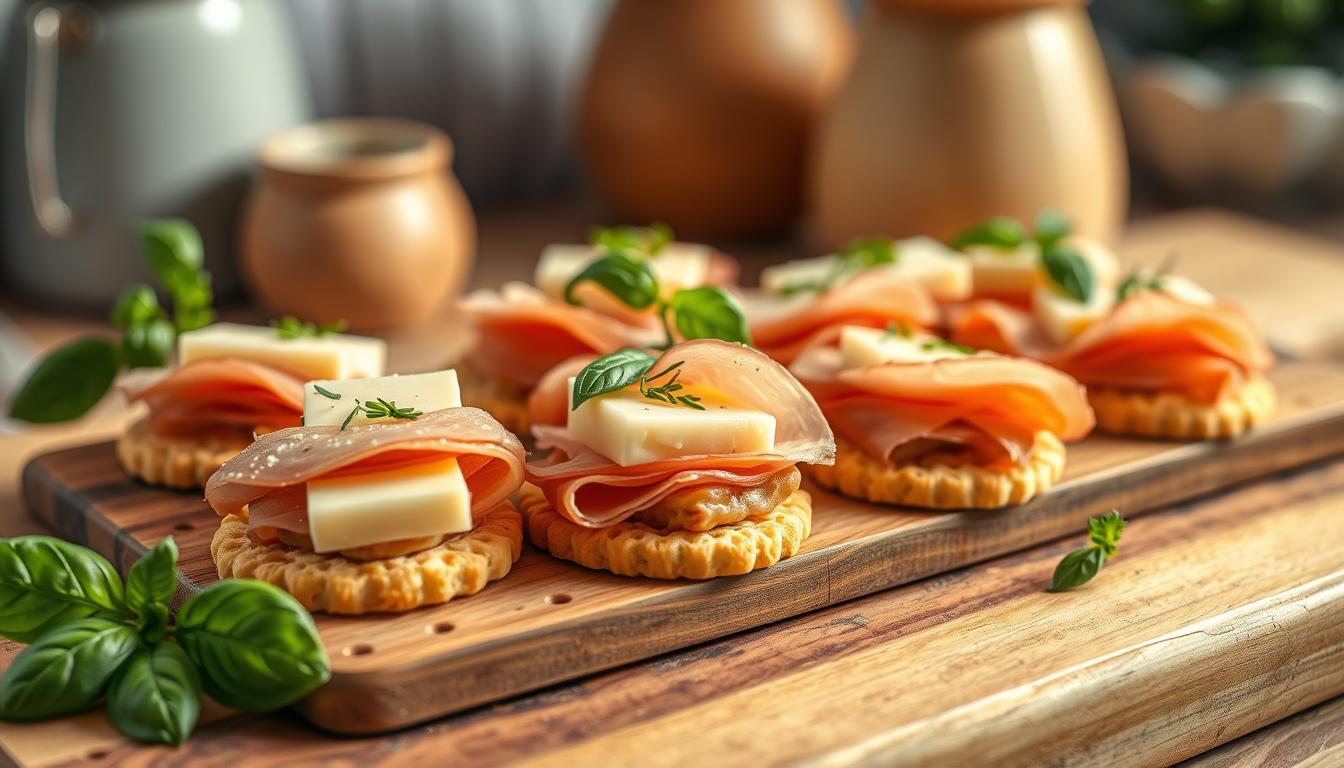Are you living with endometriosis and finding it hard to find snacks that don’t make your symptoms worse? This delicious crackers cheese ham combo is here to help! Endometriosis affects 10-15% of women, causing pelvic pain, digestive issues, and hormonal imbalances. But, making smart food choices can help manage these symptoms.
Recent studies show that an anti-inflammatory diet can greatly help those with endometriosis. By avoiding processed foods, red meat, gluten, and dairy, and focusing on whole foods, you can reduce inflammation and balance hormones. Our endo-friendly crackers, cheese, and ham snack is a great choice!
Understanding Endometriosis and Its Dietary Needs
Endometriosis is a chronic condition that affects 10-15% of women worldwide. It happens when tissue like the uterine lining grows outside the uterus. This tissue thickens, breaks down, and bleeds with each cycle, but can’t leave the body.
This leads to inflammation, scarring, and adhesions. The main symptom is pelvic pain. Other symptoms include heavy and painful periods, painful sex, fatigue, and infertility. While there’s no cure, a treatment plan can improve life quality.
An anti-inflammatory diet can help manage symptoms. It focuses on reducing dietary triggers to lessen pain and inflammation.
Endometriosis and the Anti-Inflammatory Diet
An anti-inflammatory diet for endometriosis aims to reduce inflammation and support hormone balance. This diet involves:
- Limiting or avoiding processed foods, red meat, pork, gluten, dairy, unhealthy oils, caffeine, alcohol, and sugar.
- Emphasizing anti-inflammatory foods like leafy greens, fruits, vegetables, whole grains, lean proteins, and healthy fats.
- Incorporating liver-supporting superfoods like cruciferous vegetables, beets, onions, garlic, turmeric, and ginger.
- Ensuring adequate intake of omega-3 fatty acids from sources like cold-pressed oils, nuts, seeds, and fatty fish.
By following an endometriosis-friendly diet, women can manage pelvic pain and support hormone-balancing nutrition.
Foods to Avoid for Endometriosis
Living with endometriosis means some foods can make symptoms worse. To fight inflammation and balance hormones, we should avoid or limit certain foods.
Processed and Packaged Foods
Processed foods often have hormone-disrupting ingredients and additives that can make endometriosis symptoms worse. Choose whole, less processed foods instead.
Red Meat and Pork
Too much red meat and pork can lead to more body inflammation because of their inflammatory fats. Try leaner proteins like poultry, fish, or plant-based options.
Gluten and Dairy
Gluten and dairy can be endometriosis trigger foods that increase inflammation. Look for gluten-free and dairy-free alternatives in processed foods.
Unhealthy Oils, Caffeine, Alcohol, and Sugar
Vegetable, corn, and soybean oils, too much caffeine, alcohol, and sugar are all inflammatory foods to avoid for endometriosis sufferers.
By watching what we eat and choosing better options, we can manage endometriosis symptoms and improve our health.
Emphasizing Anti-Inflammatory Foods
For those with endometriosis, an anti-inflammatory diet is very helpful. It focuses on foods that are good for you and help with pain. Unlike bad foods, there are many healthy, anti-inflammatory options. These can help with endometriosis symptoms and keep you healthy.
Some important anti-inflammatory, hormone-balancing foods to add to your diet include:
- Leafy greens like spinach, kale, and arugula, which are rich in antioxidants and anti-inflammatory nutrients
- Fatty fish such as salmon, mackerel, and sardines, providing anti-inflammatory omega-3s
- Nuts and seeds like walnuts, flaxseeds, and chia seeds, also high in omega-3s
- Turmeric, ginger, and other anti-inflammatory spices and herbs
- Berries, including blueberries, raspberries, and strawberries, packed with polyphenols
- Avocados, which are an excellent source of healthy fats and fiber
Adding more of these pain-relieving, hormone-balancing foods to your diet can change your life. By choosing an anti-inflammatory diet, we can lower inflammation. This helps ease symptoms and supports our health.
Fruits and Vegetables: The Foundation
Managing endometriosis starts with a good diet. Focus on endometriosis-friendly produce. Try to eat at least 5 servings of fresh, organic nutrient-dense fruits and veggies every day. This helps you get the vitamins, minerals, antioxidants, and fiber you need.
Leafy greens like spinach, kale, and arugula are great. They’re full of nutrients that fight inflammation and help balance hormones. Also, add berries, citrus fruits, broccoli, cauliflower, and bell peppers to your diet. These foods are low in calories but packed with nutrients to help manage endometriosis symptoms.
Eating a variety of colorful fruits and vegetables boosts your antioxidants. This can lower your risk of endometriosis and pain. By making these foods the base of your meals and snacks, you support your health and wellbeing.
Nutrient-Dense Options to Prioritize
- Leafy greens (spinach, kale, arugula)
- Berries (blueberries, raspberries, strawberries)
- Citrus fruits (oranges, lemons, limes)
- Broccoli and cauliflower
- Bell peppers
Endo friendly crackers cheese ham
Finding good snacks with endometriosis can be tough. But we found a great mix – endometriosis-friendly crackers, dairy-free cheese, and antiinflammatory ham. It’s perfect for those looking for a low-FODMAP, gluten-free, and nut-free snack.
The crackers are made with special, low-FODMAP ingredients to avoid digestive issues. They pair well with creamy, dairy-free cheese alternatives. The antiinflammatory ham adds protein without the usual inflammation.
This endometriosis-friendly snack is great for a quick snack or a healthy meal. It’s full of nutrients and tastes amazing. It helps nourish your body and mind while managing symptoms.
Next time you need a tasty and endo-friendly snack, try this mix of crackers, cheese, and ham. Your body and taste buds will love it!
Gluten-Free Whole Grains and Starches
For those with endometriosis, gluten-free whole grains and starchy veggies are great alternatives. Foods like quinoa, brown rice, sweet potatoes, and winter squash are full of complex carbohydrates. They also have fiber and important vitamins and minerals, without gluten’s inflammation.
These nutrient-dense complex carbs help with digestion and lower body inflammation. The fiber in these gluten-free grains and endometriosis-friendly starches helps with regular bowel movements. This is key for getting rid of excess estrogen and hormones.
When picking gut-healthy foods, go for whole, unprocessed foods. They nourish your body and help manage endometriosis symptoms.
| Gluten-Free Grains | Complex Carbohydrates | Endometriosis-Friendly Starches |
|---|---|---|
| Quinoa | Brown Rice | Sweet Potatoes |
| Buckwheat | Oats | Winter Squash |
| Millet | Amaranth | Potatoes |
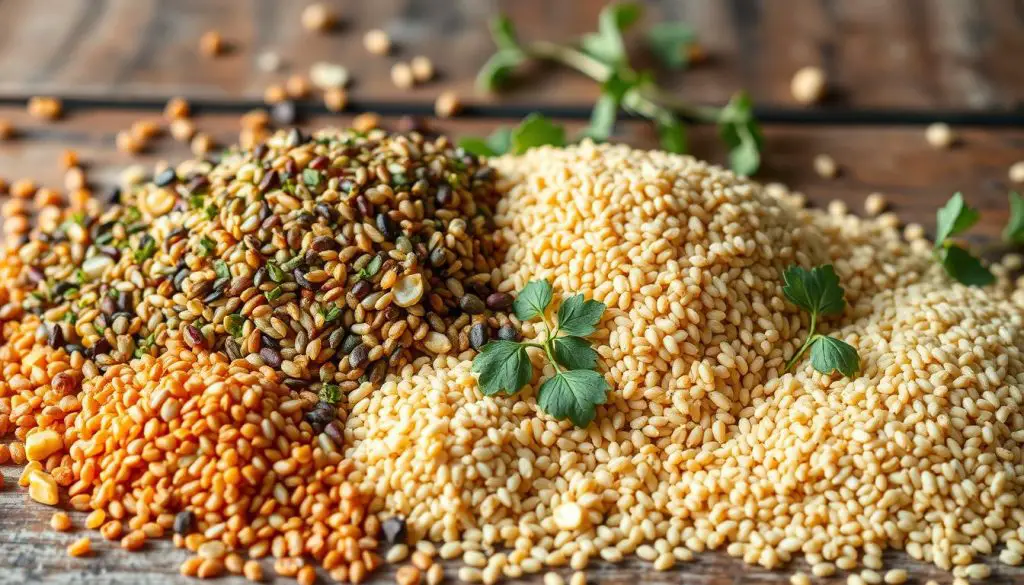
Adding these gluten-free whole grains and complex carbohydrates to your diet can boost your health. It also helps manage endometriosis symptoms better.
Plant and Lean Protein Sources
Managing endometriosis means focusing on proteins that fight inflammation and balance hormones. Adding plant-based protein and endometriosis-friendly meats to our diet is key. This helps our bodies and eases symptoms.
Some top plant-based protein choices are:
- Lentils
- Chickpeas
- Quinoa
- Oats
- Tofu and tempeh
- Nuts and seeds
For endometriosis-friendly meats, go for lean, organic, and hormone-free. This includes:
- Grass-fed beef
- Free-range poultry
- Wild-caught fish
These hormone-balancing foods and anti-inflammatory protein sources fight inflammation. They support hormonal balance and give our bodies the nutrients needed to manage endometriosis.
By eating a mix of nutrient-rich, anti-inflammatory proteins, we nourish our bodies. This helps reduce endometriosis symptoms and boosts our overall health.
Liver-Supporting Superfoods
The liver is key in getting rid of extra hormones in our body. This is important for those with endometriosis. Eating certain foods can help the liver detox and manage symptoms.
Cruciferous Veggies: Detox Dynamos
Broccoli, cauliflower, and Brussels sprouts are full of nutrients. They help the liver work better. These veggies have sulforaphane and indole-3-carbinol, which help get rid of bad estrogen.
Beets: Bountiful Beetroots
Beets are amazing for the liver. They are full of betalains, which help the liver clean toxins better.
Alliums: Aromatic Allies
Garlic, onions, and other alliums are great for the liver. They have sulfur compounds that make more glutathione. Glutathione is a strong antioxidant for the liver.
Ginger and Turmeric: Spicy Superstars
Ginger and turmeric are known for fighting inflammation. They are good for people with endometriosis. They have gingerol and curcumin, which help the liver detox.
Eating these superfoods can help your body fight endometriosis symptoms. Try new recipes to enjoy these endometriosis detox foods and hormone-balancing ingredients.
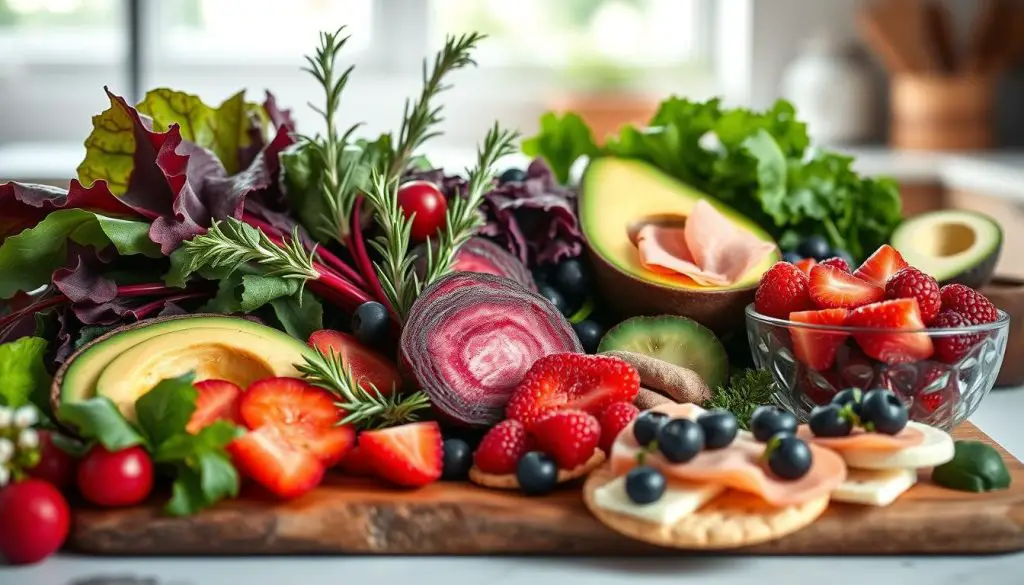
The Role of Omega-3 Fatty Acids
Endometriosis is an inflammatory condition that causes severe pelvic pain. Luckily, omega-3 fatty acids can help reduce inflammation and ease symptoms. These fats are found in many foods that are good for an endometriosis diet.
Omega-3 Rich Foods for Endometriosis
- Cold-pressed oils: Flaxseed, chia seed, and walnut oils are great for fighting inflammation.
- Nuts and seeds: Walnuts, chia seeds, and flaxseeds are full of omega-3s that help with endometriosis.
- Fatty fish: Wild-caught salmon, mackerel, sardines, and anchovies are rich in omega-3 essential fatty acids.
Research shows that women who eat a lot of long-chain omega-3s, like in fatty fish, might be 22% less likely to get endometriosis. Adding these omega-3-rich foods to your diet can help manage endometriosis.
Omega-3s also help reduce pain from endometriosis. They balance the body’s inflammatory response, giving much-needed relief to those with this chronic condition.
Soy and Phytoestrogens: The Debate
The role of soy in endometriosis nutrition is a hot topic. Soy has compounds called isoflavones that can act like estrogen or block it. How soy affects endometriosis depends on many factors, including your hormones.
Balancing the Benefits and Risks
Research shows that moderate soy intake might not raise endometriosis risk for most women. In fact, soy and other phytoestrogens could help balance hormones. This makes them a possible ally in managing endometriosis symptoms.
But, soy affects people differently. Some women with endometriosis might be more sensitive to soy’s estrogenic effects. It’s key to watch how your body reacts to soy and endometriosis. Keep an eye on your symptoms and dietary needs to find the right soy amount for you.
If you’re thinking about adding soy to your diet, start with small amounts. See how your body reacts. Talking to a healthcare expert who knows about endometriosis can also help figure out the right soy amount for you.
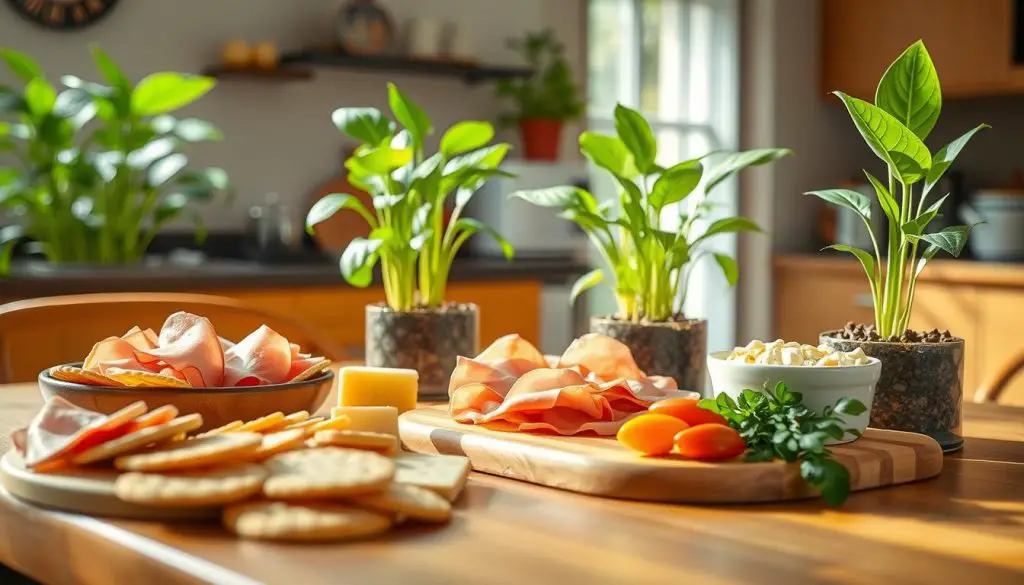
Meal Planning and Preparation Tips
Managing endometriosis-friendly meal prep and chronic illness cooking strategies can be tough, mainly when symptoms get worse. But, with some smart time-saving recipes, you can have healthy meals and snacks ready.
Begin by setting aside a few hours on the weekend for batch cooking. Make extra of your favorite dishes like roasted veggies, whole grains, and lean proteins. Then, portion them out and keep them in the fridge or freezer for quick meals all week.
Also, make sure your pantry and fridge are stocked with endometriosis-friendly staples. This helps you whip up healthy meals and snacks fast, even when you’re tired or busy.
- Focus on simple, one-pot meals like vegetable soups, stews, and casseroles that need little prep.
- Use your slow cooker or Instant Pot for easy, hands-off meals that are ready when you need them.
- Pre-cut and pre-portion ingredients like fruits, veggies, and proteins to make meals easy to assemble.
- Keep a list of your favorite endometriosis-friendly meal prep recipes for planning your meals.
By being proactive with chronic illness cooking strategies, you can keep your body nourished and manage symptoms, even on the busiest days.
| Restaurant | What to Avoid | Good Options |
|---|---|---|
| Panera Bread | High-calorie and high-fat salad options | Low-calorie and low-fat salad options |
| Chipotle | High-fat and high-calorie options due to toppings like guacamole, sour cream, and cheese | High-protein options with limited fat and calories, focusing on items like veggies and salsa instead of high-fat toppings |
| Subway | High-fat and high-calorie sandwich options | Lower calorie and fat sandwiches with high protein content, recommended to add veggies and spinach for added flavor without extra calories |
| Chick-fil-A | Fried chicken options and high-fat dressings | Grilled chicken options without fried components, along with a side salad for a bariatric friendly meal |
Snacking for Sustained Energy
Living with endometriosis can be tough, making it hard to eat full meals on bad days. But, healthy snacks can give you the energy you need. Try endometriosis-friendly snacks, energy boosters, and anti-inflammatory snacking options. They help keep you going and manage symptoms.
Nourishing Snack Ideas
- Hummus with fresh, crunchy veggies like carrots, bell peppers, or cucumber slices
- Avocado toast on whole-grain bread or crackers
- Trail mix made with nuts, seeds, and dried fruit
- Baked sweet potato fries or lentil-based crackers
- Nonfat Greek yogurt topped with berries and a sprinkle of cinnamon
- Roasted edamame or baked cheese crisps
- Fresh mozzarella and tomato skewers drizzled with balsamic glaze
These snacks are full of nutrients and can help fight inflammation from endometriosis. Having a variety of endometriosis-friendly snacks ready can help keep your energy up all day, even when you’re busy.
| Snack | Calories | Total Fat | Carbs | Protein | Fiber |
|---|---|---|---|---|---|
| Cracker, Cheese, Ham Endo-Friendly Snack | 37 | 0.4g | 8g | 2g | 2.5g |
| Sugar-free Hot Cocoa | 70 | – | – | – | – |
| Baked Potato Chips and Salsa | 12 | – | – | – | – |
| Microwave or Air-popped Popcorn | 31 | – | 6g | – | – |
| Oatmeal and Berries | 77 | – | 14g | 3g | 2g |
It’s key to listen to your body and try different nutrient-dense energy boosters to see what works for you. Getting advice from a healthcare provider or registered dietitian can also help. They can give you personalized tips to improve your health.
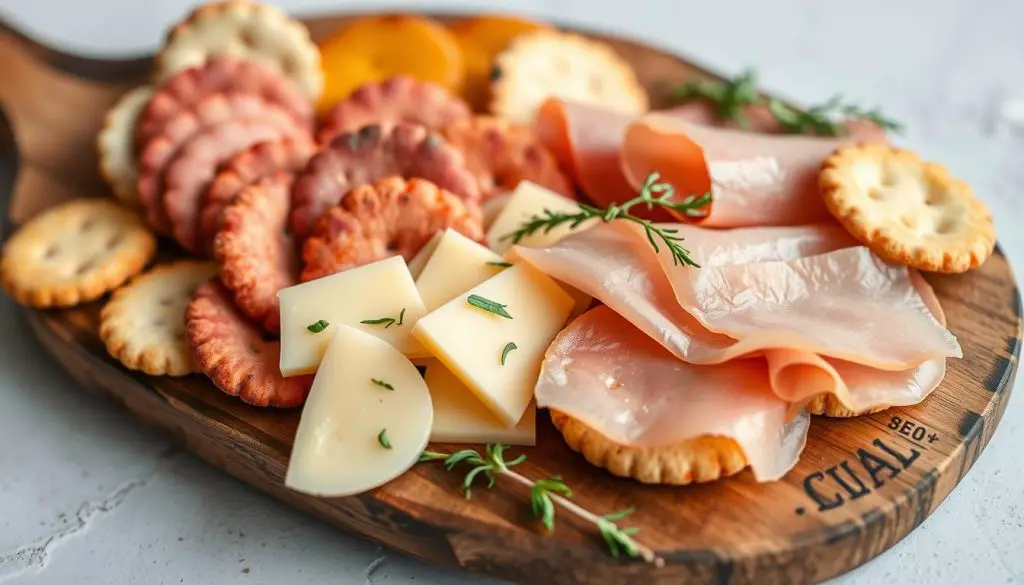
Batch Cooking for Convenience
Living with endometriosis can be tough, but meal prep can help a lot. Cooking big batches of healthy meals is a big help. It makes our lives easier.
Cooking extra of dishes like soups and stews is smart. It gives us healthy meals ready to go when we’re busy or feeling bad. This way, we always have good food that’s easy to make.
Spending a few hours on the weekend to cook can be a big time saver. We can make lots of meals that are full of nutrients. These meals are great for when we’re not feeling well.
- Batch cook hearty soups, stews, and casseroles that can be easily portioned and frozen for later.
- Prepare extra servings of roasted vegetables, grains, and lean proteins to mix and match for quick, balanced meals.
- Make big batches of sauces, dips, and dressings to have on hand for easy meal assembly.
- Chop and store fresh produce like greens, carrots, and bell peppers for grab-and-go snacks and salad toppings.
Batch cooking is a great way to manage endometriosis. It lets us have healthy, easy meals even when we’re really busy.
Stocking a Chronic Illness-Friendly Pantry
Having a well-stocked pantry is key to making nourishing meals, even on tough days. Keep healthy fats like olive oil, coconut oil, and avocado oil handy. Also, have anti-inflammatory spices like turmeric, ginger, and garlic ready. And don’t forget gluten-free whole grains like quinoa, brown rice, and oats.
Time-saving meal components like canned beans, lentils, and tuna are great for quick meals. Make sure to have plenty of fresh, organic produce too. Fruits and vegetables are essential for an anti-inflammatory diet.
By stocking your pantry with anti-inflammatory ingredients, you support your health and manage symptoms. This proactive approach helps maintain a balanced diet and well-being with chronic conditions like endometriosis.
Source Links
- https://dieteticallyspeaking.com/how-to-eat-well-with-a-chronic-illness/
- https://www.lemon8-app.com/resepimakananbayi/7261559232817054210?region=us
- https://www.ncbi.nlm.nih.gov/pmc/articles/PMC9319875/
- https://drkathleenmahannah.com/blog/endometriosis-foods-to-eat-and-avoid
- https://www.medicalnewstoday.com/articles/interstitial-cystitis-diet
- https://www.ncbi.nlm.nih.gov/pmc/articles/PMC9536822/
- https://www.openhealthtools.org/are-graham-crackers-low-fodmap/
- https://www.science.gov/topicpages/c/cat cracker feed
- https://www.yourlifestylemedics.com/blog/eat-to-beat-inflammation
- https://www.everydayhealth.com/hs/managing-type-2-diabetes/best-and-worst-foods/
- https://www.everydayhealth.com/type-2-diabetes/diet/diabetes-snacks/
- https://www.lemon8-app.com/pcos.endo.nikki/7375157765808947717?region=us
- https://www.ncbi.nlm.nih.gov/pmc/articles/PMC5866307/
- https://www.everydayhealth.com/diet-nutrition/gluten-free-diet/
- https://www.healthline.com/health/easy-to-digest-foods
- https://www.usenourish.com/blog/low-fiber-diet-menu-examples
- https://www.thehouseofacupuncture.co.nz/spleen-diet-gut-health-digestion-chinese-medicine-acupuncture
- http://tmj.org/wp-content/uploads/2020/08/TMJ_nutrition_Guide.pdf
- https://www.healthpartners.com/blog/how-to-lower-high-blood-pressure-through-diet/
- https://www.mountsinai.org/health-library/special-topic/m-ni-re-disease-self-care
- https://waitemataendoscopy.co.nz/images/pdf/low-fibre-diet-info-for-colonoscopy.pdf
- https://www.everydayhealth.com/diet-and-nutrition/the-tlc-diet.aspx
- https://www.chelwest.nhs.uk/your-visit/patient-leaflets/bariatric-dietetics/dietary-guidance-after-intra-gastric-balloon-insertion
- https://www.barilife.com/blog/bariatric-friendly-restaurants/?srsltid=AfmBOoq8jZb3bLn4GCaa1kvk5dFLDW4mT6rj1XHLzm5JL27F626OinAL
- https://ivfturkey.com/what-foods-help-in-your-ivf-treatment/
- https://www.huggies.co.ke/toddler/toddler-food/lunch-box-ideas/
- https://www.sharecare.com/diet-nutrition/snacks-under-100-calories
- https://happy-medium.net/category/my-week-with-celiac/
- http://theoildrum.com/node/9145
